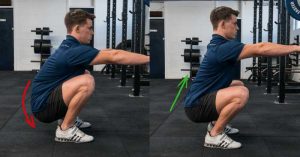by: Regan Colley
Social Media has become one of the most influential fitness. With quick and easy access to fitness “information” or “trends”, individuals can get numerous ideas and apply them to their fitness routines. While this can be helpful, it can also be harmful. One of the most recent trends that is sweeping the internet is on a popular video streaming application properly used to post short videos for comedy or informational purposes. The most recent trend that has been spreading is the trend of individuals comparing their “squat depth”. The trend is spreading the idea that if an individual’s squat depth does not exceed the squat rack safety bar, then it is not valid. For example, on most videos, the commenters say that “if the squatter’s butt is not touching the ground, the rep is not valid” or even “that the rep is not completed if the squatter does not squat below the squat safety rack”. These comments are not accurate and ignore the fact that exercise programming should take an individualized approach.. When doing a proper squat, proper form should take priority over squat depth and squat depth will depend on the goals, abilities and limitations of that specific individual.
An individual must have proper form, this is due to the fact that when an individual does not have proper form, they are at a higher risk for lower back injuries due to improper kinetics such as lumber shear forces with lumbar flexion (Schoenfeld et al. 2010). When an individual does not have proper form and does not maintain a upper trunk parallel or neutral lower back position, it can cause the individual to have what is commonly referred to as a “butt wink” and can cause excess pressure on the lumbar portion of the spine and on the intervertebral disks which can lead to injury.
Picture from:
Comment corriger le Butt Wink et améliorer la posture du squat ? (wodnews.com)
In order to combat potential risks to this trend, individuals should do simple exercises in order to improve form and decrease injury risk to themselves. These exercises can be done at home and are simple and effective to improving overall form when performing an overhead squat (Cruz 2022). The first exercise that individuals can perform what is called a “Hip Hinge”. Individuals can perform this in order to feel the basics of what proper squat position is while also correcting the twinging of the lower back or the “butt wink” and even arching the lower back. The second exercise is called a “Hip Bridge with a Resistance Band”. The purpose of this exercise is to establish gluteal activation in order to correct lumbar positioning (Cruz 2022). Both of these exercises can help individuals with their form, and extend their knowledge and decrease injury risk from improper form. Ultimately, it is vital individuals are knowledgeable about what proper form is when performing any exercise, especially with exercises that utilize weights with it because when individuals follow instant trends they can be more susceptible to serious injuries such as lower back injuries.
References
David Cruz, D. C. (n.d.). Squat form – what does it tell us? part 2. NASM. Retrieved February 28, 2022, from https://blog.nasm.org/newletter/squat-form-tell-us-part-2
Schoenfeld, B. 2010. Squatting Kinematics and Kinetics and Their Application to Exercise Performance. Journal of Strength and Conditioning Research 24(12):3497-3506.
David Cruz, D. C. (n.d.). Squat form – what does it tell us? part 1. NASM. Retrieved February 28, 2022, from https://blog.nasm.org/newletter/squat-form
